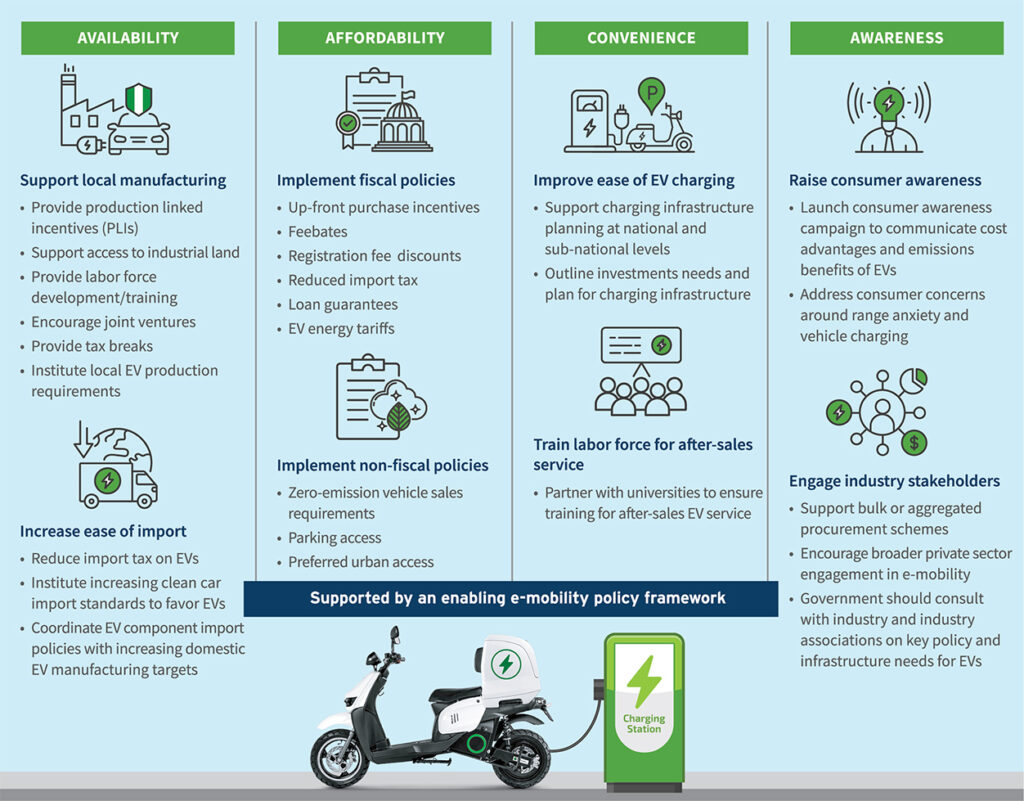
Nigeria’s Ambitious Goal of a Clean Transportation Sector
Although the challenges seem immense, a new RMI report lays out a path forward for electric mobility in Nigeria.
Nigeria is on a mission to decarbonize its transportation sector. The African continent’s most populous nation has pledged to have all new sales of cars and vans be zero emissions by 2040. This is part of the country’s ambitious goal to reach carbon neutrality by 2060. Electric mobility is the most cost-effective path to achieving these laudable goals. Electrifying transportation in Nigeria will not only help the country reach its climate goals but will also improve the lives of its citizens, many of whom struggle to cope with rising transportation costs resulting from the end of the country’s fuel subsidy.
To help Nigeria make the transition to electric mobility, RMI took an in-depth look into the Nigerian transportation sector, analyzing the electric mobility opportunities and anticipated challenges, and providing steps for a successful path forward.
Nigerian transportation challenges
In May of 2023, Nigerian President Bola Tinubu got rid of the fuel subsidy that kept the nation’s gas prices at a reasonable level. The president said this move was to “rechannel the funds into better investment in public infrastructure, education, health care, and jobs.” However, this unpopular decision nearly tripled gasoline prices, and has had reverberating effects on the economy in the year since.
Even before the removal of the subsidy, Nigerians had difficulty getting where they needed to go: the 14,000 vehicles the country produces each year is far below annual demand of 720,000. To meet this colossal demand, the country imports hundreds of thousands of vehicles, most of which are used, each year. This reliance on imports does little to benefit the economy, costs the country an estimated $8 billion each year, and produces considerable emissions. And based on the country’s current growth trajectory, the transportation demand in the country is expected to more than double by 2050, with a corresponding impact on greenhouse gas emissions.
That is why Nigeria is pushing for change — change that can result in not only economic growth, but also improved access to transportation, economic savings for Nigerians, and reduced air pollution.
Our latest report, A Vision for E-Mobility in Nigeria, provides a framework that government officials, EV manufacturers, financiers, nongovernmental organizations, and other transportation stakeholders can use to advance their e-mobility efforts.
6 actions to drive e-mobility growth
It may seem like an incredibly ambitious goal to electrify the country’s transportation sector in line with its net-zero targets: as the government’s analysis has shown, 60 percent of passenger cars will need to be EVs by 2050, and the electrification of both two-wheeler and three-wheeler vehicle fleets would need to move at an even faster pace. However, there is currently a lack of locally available electric vehicles. And even if there were more vehicles available, it would be hard for many Nigerians to afford them as there is very little access to cost-effective financing for EVs.
The lack of charging infrastructure in the country, the varying reliability of the grid, and the low awareness of e-mobility options also make it difficult for people to choose EVs over gasoline- and diesel-powered vehicles. However, our report outlines how Nigeria can tackle these barriers and move forward on the path to e-mobility through six main recommendations.
- Supportive policies, both fiscal and non-fiscal, are critical. Tax exemptions and vehicle purchase subsidies can help ease the cost of EVs for consumers, and feebates in the form of taxes on the sale of polluting vehicles can help shift consumers to EVs. Loan guarantees are also a tool that the Nigerian government can employ to lower interest rates for EV purchases. Supply-side non-fiscal policies can include EV sales mandates and placing limits on emissions intensity.
- The Nigerian government can support local manufacturing of EVs, especially in the last stages of the EV supply chain — the final assembly. These operations can then eventually be diversified to incorporate other parts of the EV supply chain, including vehicle design and battery manufacturing.
- As local manufacturing takes hold over time, parallel policies to enable bulk procurement can create demand and justify local manufacturing. Bolstering local manufacturing and streamlining procurement in bulk can create new job opportunities and bring economic development to different regions of the country.
- Making EVs more affordable requires establishing financing facilities to de-risk EV lending. Given the nascency of the EV industry, risk-sharing arrangements can help local commercial financiers provide affordable prices to customers. This will require partnerships between financiers and socially focused organizations (i.e., the government or development finance institutions).
- Reliable and robust charging infrastructure is also key. Several factors must be considered in the deployment of charging infrastructure such as prioritizing e-bus and two-wheeler charging, standardizing charging through interoperability, improving grid reliability by utilizing renewable energy sources, and ensuring strong after-sales services for customers. Viable charging business models need to be identified and encouraged to fit Nigeria’s variable grid reliability.
- Promoting awareness of the cost and health benefits of EVs can further drive demand. Generating positive attention would also signal to smaller fleets and other stakeholders in the country that transportation electrification business models are achievable. Building confidence that EVs can be scaled in Nigeria would also bring more investment into the industry in the long-term.
Nigeria, with its large domestic market and deep pool of highly qualified labor, is in a strong position to lead the transition to electric mobility in Africa. Overcoming the challenges may seem daunting but, as other economies have shown, the rewards — economic development, reduced transportation costs, job creation, reduction of import dependency, and a leadership position in Africa’s energy and transportation transition — are substantial.
Nigeria should act now to seize these considerable benefits.

A Vision for E-Mobility in Nigeria was co-authored with Energy Transition Office Nigeria. We would like to thank them for acting as a key partner in the creation of this report. ETO Nigeria supports the Nigerian government in the implementation of its Energy Transition Plan, and is resourced by the Global Energy Alliance for People and Planet and Sustainable Energy for All.